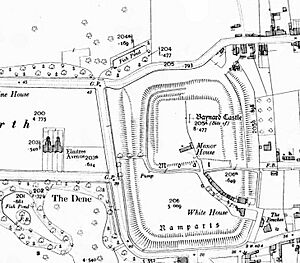Baynard Castle, Cottingham facts for kids
Imagine a strong castle with a moat, built a long time ago in England! That's Baynard Castle. It was built in the 1100s and 1200s in a village called Cottingham, in a place called the East Riding of Yorkshire. People sometimes called it 'the castle at Cottingham' or 'Stuteville's castle'. The name 'Baynard Castle' became popular later, in the 1800s.
Contents
What Baynard Castle Looked Like
Baynard Castle was shaped like a big rectangle. It had a protective bank and a ditch all around it, covering about 11 acres. That's like 11 football fields! The northern part of the castle had an extra ditch for more protection.
Experts think a main tower, called a keep, stood in the north-east corner. The entrance you see today in the south-east part of the site is probably where the original entrance was.
A Look at the Castle's History
People first mentioned a manor house (a large country house) at this spot in Cottingham around the 1170s.
Early Days and Royal Visits
In the year 1200, a man named William de Stuteville hosted King John I at Cottingham. The King gave him permission to hold a market and to make his castle stronger. In 1201, William got a special permission, called a licence to fortify, to build walls and make the site a proper fortress.
By 1272, the castle had a moat. In 1282, people noted it had a boundary wall and a double ditch.
New Owners and Changes
The de Stuteville family line ended in 1233. The castle then went to the le Wake family. King Edward I even stayed at the castle during Christmas in 1299!
In 1327, Thomas Wake received another special permission, called a licence to crenellate. This allowed him to add battlements (the notched tops of castle walls) to the castle. However, by the time Thomas Wake died in 1349, the manor house was said to be falling apart.
After Thomas Wake's death, the castle was passed to the Earles of Kent through his sister, Margaret Wake. In 1365, repairs began on the manor, and a new gate was ordered to be built.
The Castle's Decline
In 1407, the Cottingham manor was divided among three daughters. After this, the castle seems to have stopped being used much. Even though the gatehouse was rebuilt around 1500 or 1501, the main castle was no longer important.
By 1538, a writer named John Leland visited the area. He wrote that he saw farmhouses built inside the old castle's boundaries. He said:
Entering into the South Part of the great Uplandisch Town of Cotingham, I saw wher Stutevilles Castelle, dobill dikid and motid, stoode, of the which nothing now remanynith.
—John Leland, itinerary 1538.
This means he saw where the castle once stood, with its double ditches and moat, but nothing was left of it. By 1590, another writer, William Camden, described the castle as a ruin.
The Manor House Legend
There's a story about an earlier manor house that was supposedly destroyed in 1541. The owner was expecting a visit from King Henry VIII. Fearing the King's visit, the owner supposedly ordered the house to be set on fire. This way, he could avoid the King's stay.
The building known today as the Old Manor House (or Sarum Manor) is located in the southern part of the castle site. It's outside the second ditch. People believe it was built in the 1500s, with some changes made in the 1900s. This building is a two-story house made with timber frames. It's considered a special historic building.
Baynard Castle Today
The name Baynard Castle has been used since at least the 1800s. Since 1949, the castle site has been protected as a scheduled ancient monument. This means it's an important historical place.
Besides the Old Manor House, there are two other historic buildings on the castle site. One is a coach house with stables. The other is 'The White House'. Both are two-story brick buildings from the 1700s, located on the path leading to the castle site.


